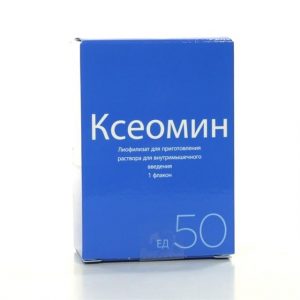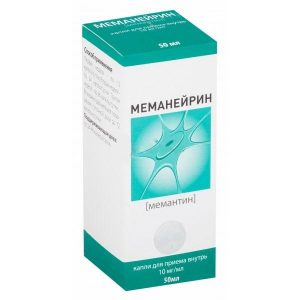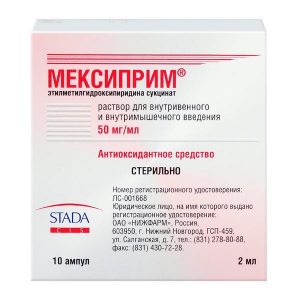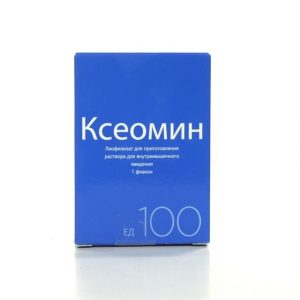Description
Latin name
Neurox
Release form
Solution for iv and intramuscular administration transparent colorless or slightly yellowish.
Packaging
5 ml – ampoules of dark glass (5) – blister strip packaging (1) – packs of cardboard.
Pharmacological action
Antioxidant preparation. Ethylmethylhydroxypyridine succinate (EMHPS) is an inhibitor of free radical processes, a membrane protector with antihypoxic, stress-protective, nootropic, anticonvulsant and anxiolytic effects. Belongs to the class of 3-hydroxypyridines. The mechanism of action is due to antioxidant and membrane-protective properties.
Suppresses lipid peroxidation, increases superoxide oxidase activity, increases lipid-protein ratio, improves cell membrane structure and function. Modulates the activity of membrane-bound enzymes, receptor complexes, which contributes to their binding to ligands, preserving the structural and functional organization of biomembranes, transport of neurotransmitters, and improving synaptic transmission.
Increases dopamine concentration in the brain. It enhances the compensatory activation of aerobic glycolysis and reduces the degree of inhibition of oxidative processes in the Krebs cycle under hypoxia with an increase in adenosine triphosphoric acid and creatine phosphate, and activates the energy-synthesizing function of mitochondria.
Increases the body’s resistance to various damaging factors in pathological conditions (shock, hypoxia and ischemia, cerebrovascular accident, intoxication with ethanol and antipsychotic drugs). Improves metabolism and blood supply to the brain, microcirculation and rheological properties of blood, reduces platelet aggregation.
Stabilizes the membrane of blood cells (red blood cells and platelets), reducing the likelihood of hemolysis. It has a lipid-lowering effect, reduces the content of total cholesterol and LDL. It normalizes metabolic processes in the ischemic myocardium, reduces the necrosis zone, restores and / or improves the electrical activity and contractility of the myocardium, and also increases coronary blood flow in the ischemia zone, increases the antianginal activity of nitro drugs, and reduces the effects of reperfusion syndrome in acute coronary insufficiency.
Stress-protective effect is manifested in the normalization of post-stress behavior, somatovegetative disorders, restoration of sleep-wake cycles, impaired learning and memory processes, and reduction of dystrophic changes in various brain structures.
EMHPS has a pronounced antitoxic effect in withdrawal symptoms, eliminates neurological and neurotoxic manifestations of acute alcohol intoxication, and corrects behavioral and cognitive impairment. Under the influence of ethylmethylhydroxypyridine succinate, the effect of tranquilizing, antipsychotic, antidepressant, hypnotics and anticonvulsants is enhanced, which reduces their doses and reduces side effects.
Pharmacokinetics
Absorption
When i / m is administered, the drug is determined in blood plasma for 4 hours after administration. With a / m administration, Tmax in plasma is 0.3-0.58 hours. With a / m administration at a dose of 400-500 mg Cmax in plasma is 2.5-4 μg / ml.
Distribution of
EMHPS rapidly passes from the bloodstream to organs and tissues and is rapidly excreted. The average retention time of the drug in the body with i / m administration is 0.7-1.3 hours.
Metabolism and excretion
Metabolized in the liver by glucuronidation.
Rapidly excreted in the urine mainly in the form of metabolites (50% in 12 hours) and in insignificant amounts unchanged (0.3% in 12 hours). It is most intensely excreted during the first 4 hours after taking the drug. Urinary excretion rates of unchanged drug and metabolites have significant individual variability.
Indications
Acute cerebrovascular accidents (as part of complex therapy)
Discirculatory encephalopathy
Vegetative-vascular dystonia
Anxiety conditions in neurotic and neurosis-like states of the brain cirrhosis of the brain senile and atrophic processes,
Contraindications
acute renal failure
acute liver failure
pregnancy
lactation (breastfeeding)
childhood
hypersensitivity to the components of the drug.
Caution is advised to prescribe the drug for allergic diseases and a history of reactions.
Use during pregnancy and lactation
The drug is contraindicated in pregnancy and during breastfeeding.
Composition
1 ml1 amp.
ethylmethylhydroxypyridine succinate 50 mg 250 mg
Excipients: sodium disulfite 1.0 mg, water d / and up to 1 ml.
Dosage and administration
The drug is administered in / m or in / in (stream or drip). With the infusion method of administration, the drug should be diluted in 0.9% sodium chloride solution.
Doses are selected individually. The initial dose is 50-100 mg 1-3 times / day, which is gradually increased until a therapeutic effect is obtained.
Intravenously neurox is injected slowly for 5-7 minutes, drip at a speed of 40-60 drops / min.
The maximum daily dose is 800 mg.
In acute disorders of cerebral circulation, Neurox is used as part of complex therapy in the first 2-4 days iv in a drip of 200-300 mg 1 time / day, then – in / m 100 mg 3 times / day. The duration of treatment is 10-14 days.
In case of discirculatory encephalopathy in the decompensation phase, i.v. in a stream or drip at a dose of 100 mg 2-3 times / day for 14 days, then i / m at 100 mg / day for the next 14 days.
For the course of prophylaxis of discirculatory encephalopathy – i / m at a dose of 100 mg 2 times / day for 10-14 days.
In case of neurocirculatory dystonia, neurotic and neurosis-like conditions – i / m at 50-400 mg / day for 14 days.
With withdrawal alcohol syndrome – i / m in a dose of 100-200 mg 2-3 times / day or i / v drip 1-2 times / day for 5-7 days.
In acute intoxication with antipsychotic drugs – iv in a dose of 50-300 mg / day for 7-14 days.
With mild cognitive impairment in elderly patients and with anxiety disorders, i / m at a dose of 100-300 mg / day for 14-30 days.
Side effects of
When administered parenterally (especially intravenously): dryness and a metallic taste in the mouth, sensations of spreading heat throughout the body, sore throat and discomfort in the chest, a feeling of lack of air (usually associated with an excessively high speed of administration and are short-term in nature).
With prolonged use: nausea, flatulence, sleep disturbances (drowsiness or falling asleep).
Possibly: allergic reaction.
Drug Interaction
Enhances the action of benzodiazepine anxiolytics, antiepileptic (carbamazepine), antiparkinsonian (levodopa) drugs, nitrates.
Reduces toxic effects of ethanol.
overdose
Symptoms: sleep disturbance (insomnia, in some cases drowsiness) with / in the introduction – a slight and short-term (up to 1.5 2 h) increase in blood pressure.
Treatment: usually not required – symptoms disappear on their own within a day. In severe cases, with insomnia – nitrazepam 10 mg, oxazepam 10 mg or diazepam 5 mg. In case of excessive elevation of blood pressure, hypotensive drugs are controlled by blood pressure.
Storage conditions
In a dry, dark place at a temperature of no higher than 25 ° C.
Keep out of the reach of children.
The Expiration of
is 3 years.
Do not use after the expiry date stated on the package.
Deystvuyuschee substances
tylmetylhydroksypyrydyna succinate
pharmacy prescription
prescription




